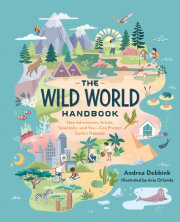Introduction: The World Outside
Humans share the planet with magnificent creatures. Some of earth’s animals, however, are so commonplace it’s easy to forget how incredible they are. The squirrels that people shoo from bird feeders are amazing acrobats who plant new trees by spreading seeds. The butterflies that pollinate gardens are resilient long-distance fliers who can cross a continent all alone. And the tree frogs that sing on summer nights can survive winter by freezing as solid as ice cubes and thawing out again in spring. Common or rare, beautiful to our eyes or not, all animals have parts to play in their habitats and in the world. When you stop to think about it, there’s really no such thing as an ordinary animal.
In
The Wild World Handbook: Creatures you’ll learn about our world’s wildlife. Some species will be familiar, and some creatures you might only ever see in nature documentaries or learn about in books. You’ll read about people who have studied and protected wildlife such as a conservation biologist named Jamal who’s saving endangered manatees, a herpetologist named Joan who taught people about misunderstood reptiles, and a writer named Beatrix who wrote illustrated books about animals and then used her earnings to protect nature. If you’re inspired by their stories, this book also has ideas for how you can study and protect wildlife too.
When we take a closer look at our fellow animals, we discover how much we have in common. Like us, they live in communities, make friends, use tools, build homes, raise families, and communicate in complex ways. But this isn’t all we share. We share habitats too. And humans have the ability to do great harm or great good to the environment we all depend on. Many animal species—from insects to polar bears—are in trouble because of climate change and other environmental threats like deforestation, overfishing, poaching, pollution, and disease. Sometimes the problems seem too big to solve. But as you may have read in
The Wild World Handbook: Habitats, people just like you can solve intimidating problems when they use their creativity and skills to work with others and commit to long-term action. No matter what happens, it’s important to keep protecting the habitats and creatures in our wild world. When we help animals and the places they live, we help ourselves too.
Copyright © 2021 by Andrea Debbink; illustrated by Asia Orlando. All rights reserved. No part of this excerpt may be reproduced or reprinted without permission in writing from the publisher.











